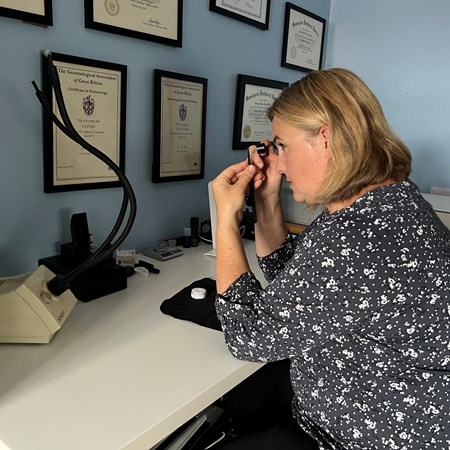Thinking of selling?
Get a free auction estimate by submitting your item online. Selling has never been easier with Griffin’s Auctioneers.
Valuing Diamonds

Diamond is the hardest substance on Earth. Its popularity is unrivalled and it is easily the most important gemstone in the jewellery industry, so understanding how a diamond's value is determined is vital for anyone either selling or buying them.

Both these diamonds are the same size, but the one on the left is being offered for sale at £2108 and the one on the right for £21,199 (Aug 2022 prices) That's around ten times more! But why is there such a huge price difference?
Well, when it comes to valuing diamonds the 4Cs are what most people consider.
The 4cs are: carat weight, cut, colour and clarity.
The easiest one of these to assess is carat weight. One carat is equivalent to 0.2g. Generally, the bigger the diamond, the more expensive it is. There are certain carat premium weights, for example at 1ct, where the price shoots up.
Diamonds are usually prized for their colourlessness. The most widely used scale (from the GIA) has a range from D to Z with D as it’s most colourless and most valuable. As we travel further down the scale, the diamonds gain a yellowish tint.
Of course, natural diamonds can also be found in a variety of other attractive colours from pink, orange, blue through to red, purple and green. These colours, along with the strong yellow-coloured diamonds are called fancy coloured diamonds and are graded differently. As they are very rare in nature, they are generally worth a lot more than colourless diamonds.

The cut of the diamond is perhaps the hardest to assess. The symmetry, proportions and polish of the diamond all play their part in the determination of the final cut grade. It’s no surprise that the better the grade, the higher the price.
Old cut diamonds almost never achieve the highest cut grades as they were cut before modern faceting equipment was invented. However, they have become increasingly more popular in recent times as people rediscover their charms.
With modern styles, the type of cut itself doesn't affect the grade and there are a huge variety of cuts available to suit all tastes.
Some of the most popular are shown in the picture below.

Clarity refers to how transparent the diamond is. Cracks or crystal inclusions for example, especially if they are in the centre of the diamond, can have a big impact on its beauty and saleability. Diamonds are graded using a scale (again the GIAs being the most widely used) from Flawless (no flaws or blemishes seen when using a loupe) to Included 3 where the beauty and durability of the stone will be seriously affected.
However, nowadays the 4Cs aren’t the only factors a valuer needs to think about. The rise in the number of synthetic diamonds in the marketplace and the varying colour and clarity treatments available, makes valuing diamonds a much more complicated affair.
Get a free auction estimate by submitting your item online. Selling has never been easier with Griffin’s Auctioneers.
